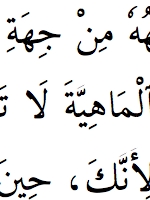
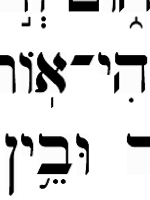
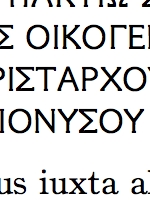
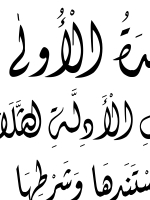
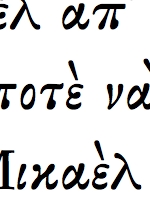
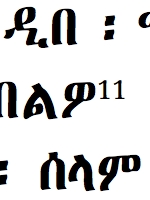
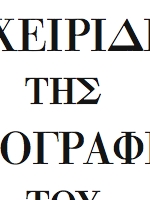
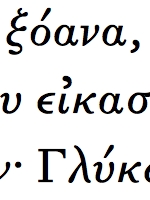
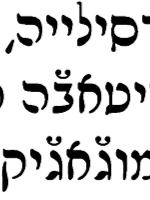
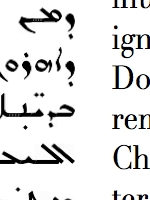
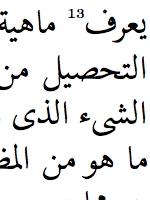
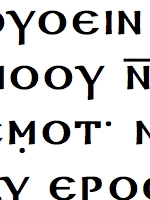
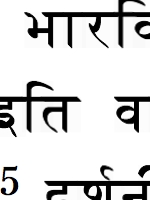
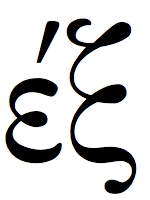
This is the TeX showcase, edited by Gerben Wierda. It contains extreme examples of what you can do with TeX, the typesetting engine from Donald Knuth, world famous mathematician, computer scientist and above all well known for TeX. I will try to keep this showcase small. For remarks on submissions, see at the end of this document.
For an introduction to TeX, please visit the TUG "Getting Started" page, and especially the section on the first LaTeX document, and in this section the PDF file of example first document with embedded explanation. I want to add to this:
You can compare a Word Processor (e.g. MS Word) setup to a TeX setup as a Camper (or RV) versus having a house and a car. The Camper is for everything: you can live in it, you can drive with it and you can look at it. The Word Processor is like a Camper: it does editing, formatting/typesetting, and displaying. It is not excellent at any of these functions, but the combination is pretty neat. In a TeX setup, these functions are separated, like with having a house and a car. You have a separate editor of your own liking to edit, and you have TeX to do the actual typesetting/formatting. Especially when using macro packages like LaTeX or ConTeXt, you write conceptually and not visually and you leave the visual aspects to the TeX engine, which (generally) produces a PDF file. You need another program again (a PDF Viewer like Acrobat or Preview on the Mac) to read or print the result. Word Processors have improved on their typesetting algorithms, but they still do not reach the quality level of TeX just yet (I am writing this on Jan 2, 2014). TeX still produces the best looking typeset text and mathematical formulas on the planet. And writing conceptually instead of visually is really nice. You can concentrate on content and you do not have to worry about layout.
Some things are, however, difficult to do in TeX. Mostly these are the kind of things where you want very fine-grained control over exact positioning of images, wrapping around these images, etc. You can do this in TeX, but it is often (very) cumbersome to get it right and changes may be a lot of work. For this, people use (very expensive) Desktop Publishing (layout) setups, like Adobe InDesign (which generally also have better typesetting algorithms than Word Processors, (almost) matching the quality of TeX) in text (though not in mathematical formulas). TeX, on the other hand, is free. The showcase shows (amongst other things) the limits of what people have been able to do with TeX in the 'special effects' category. Some of these are really TeX-specific tricks (e.g this example (PDF), which only works because TeX is a programming language, zoom in as far as you can, don't try to do this in MS Word, InDesign etc.).
In this showcase, you will not only find examples of material prepared with TeX proper, but also with macro packages like LaTeX, ConTeXt and with related programs like METAPOST. And though TeX is a typesetting language, you will find graphics and even an MPEG movie.
Showcases are mostly PDF files. Some PDF files contain tricks that only work in certain PDF-viewers, e.g. they might contain automatic changes in the page that work in certain versions of Acrobat and only when certain preferences are set. The descriptions will contain special instructions if any.
Most examples come with some sort of source. These sources are not guaranteed to compile, they are only there for visual inspection. Some may compile, but some may have parts missing.
Some of these examples were prepared using proprietary fonts or software that must be purchased. For a discussion of font usage with TeX, including a sampler of available free fonts, please see this separate font page.
One word on the sections. These are generated automatically from a database and their titles speak for themselves. The exception is the section Yannis Haralambous. Yannis is famous in the world of TeX for his work on typesetting several languages (like Greek and Hebrew) with TeX. He donated a series of samples. The Hebrew and Syrian fonts are bitmaps, they might not look perfect in all circumstances.
| Case (click for document) | Source | What it is |
|---|---|---|
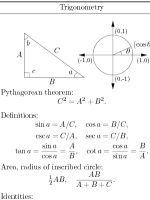 | cheat-20131114.tar.gz | Note, the source is a gzip compressed tar archive.
Submitter Martin Jansche writes: Here's an example of TeX formatting many many equations under tight space constraints: Steve Seiden's theoretical computer science cheat sheet, which used to be available from http://bit.csc.lsu.edu/~seiden/#cheat. Quoting the web page: I grant permission for you to reproduce this cheat sheet, and redistribute it for educational purposes only. You may not reproduce it for profit. If you reproduce it, you must not alter or delete my copyright.GW 2003: I have been informed that its author, Steve Seiden, died in 2002 as the result of an accident while riding his bike. As I cannot ask for permission anymore, I have taken the liberty of fixing errors reported to me. GW 2013: I have been informed by Raphael Reitzig of two errors, which have been fixed (notes in the .tex files) GW 2016: The current distribution does not properly compile, Escher's Knot is missing. I include a fixed pdf, but the source still needs repairing. Help welcome. |
| Case (click for document) | Source | What it is |
|---|---|---|
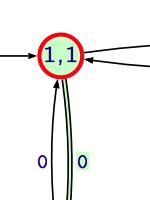 | Automaton.tex | This example shows dynamic output created with TeX. Not all previewers will be able to display the dynamism in this document, e.g. Preview.app on Mac OS X cannot handle it. But Acrobat can. Open it, set it to Full Screen and hit return a couple of times. Submitted by Stephan Lehmke. He writes: a bit of finite automata simulation done with PSTricks (automata package). |
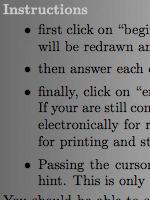 | No source available | This example does not work in all PDF-viewers (especially Mac OS X Preview.app
does not handle this). Use Acrobat. Submitter Frances Griffin
writes:
This is an example of the mathematics quizzes we are using at Macquarie University, Sydney, Australia. It uses JavaScript inside a PDF document, so that the questions are automatically marked, and on completion of the quiz, the correct answers and fully worked solutions become visible. We have set up an automated system which generates random parameters for the questions, pdfTeXs the quiz and serves a unique and personalised version of it to the student. The demo quiz here is fully self contained, but the quizzes we use for the students send the scores back to our server to be recorded. It is based on DP Story's exerquiz package, along with some customizations we have made, and pdfscreen. There are more like this here. |
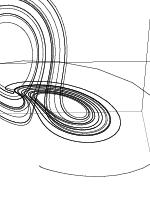 | LorenzAttractor.tex | This example does not work in all readers (e.g. it does not work in Mac OS X
10.2's Preview.app), but it works in Acrobat. Click on the picture and see it
rotate.
Submitted by Jochen Skupin |
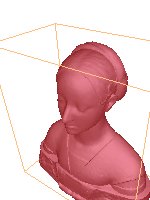 | Laurana_tex.zip | Embedding 3D objects in LaTeX. Note: does not display in Safari. Does display in Adobe Acrobat Paolo Cignoni writes: We have developed MeshLab, an open source tool that can be used to convert 3D object in a format that is directly embeddable into a pdf through the movie15 latex package. Attached a pdf produced with the above tools and a zip with the latex sources for re-creating it |
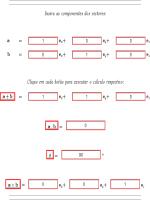 | calvec.tex | As for most dynamics, the workings depend on your viewer.
Submitter Orlando C.Rodríguez writes: This is another submission, which combines the hyperref and the insdljs packages, to create an interactive document that performs simple vector calculus operations. |
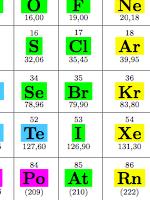 | tabela_periodica.tex | A dynamic periodic table in Portuguese. Click an entry to get extra
information. As with many dynamic examples, it depends on your viewer if this
works (Safari does not work).
Submitter Orlando C.Rodríguez writes: I'm sending you an interactive periodic table written in portuguese, using LaTeX with the color and hyperref packages. |
| Case (click for document) | Source | What it is |
|---|---|---|
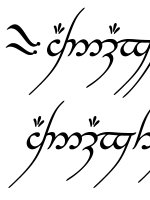 | tengwar.tex | Ignacio Fernández Galván writes: Tengwar is an alphabet invented by the J.R.R. Tolkien, which he used for representing fictional languages in his novel The Lord of the Rings and related works. There are many fonts freely available for this beautiful script, and I've created a package (tengwarscript, available at CTAN) which makes it easy to access some of these fonts in a standard way. This sample shows three short texts composed with different fonts and the tengwarscript package |
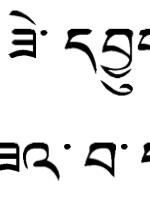 | tibetan.tex | A piece of Tibetan text which describes the Story of a Brahman and
his family.
Submitted by Norbert Preining. |
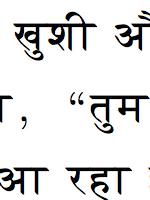 | hindi.dn | An example of Hindi, from the devnag package of Velthuis. Submitted by
Norbert Preining.
This is an example of how well TeX can be adapted to all different languages. I do not know what it says here, so do not hold me responsible. |
 | arabic.tex | An excerpt from Multilingual Typesetting with OMEGA, a Case Study: Arabic, by
Yannis Haralambous and John Plaice. These are the last three pages from the
well known torture.tex file. (This is done with Omega, the extension of TeX to
Unicode). Submitted by Norbert Preining.
This is an example of how well TeX can be adapted to all different languages, even typesetting from right to left. I do not know what it says here, so do not hold me responsible. |
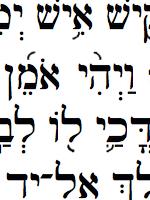 | esther-ch2.tex | Submitter Art Werschulz writes:
Alan Hoenig As an experiment, I typeset the second chapter of the book of Esther from the
Hebrew Bible. This essentially involved downloading the BHS (Biblia Hebraica
Stuttgartensia) version of Esther from the web, changing all instances of ~ to
@, adding a few lines of boilerplate to the top and the bottom of the file,
and running it through omega. BTW, I'm running MacOS X 10.2.4 on an 800MHz G4
iMac, along with your latest i-Installer distribution of the TeX stuff.
|
 | chinese.tex | Submitter Martin Jansche writes:
I'm attaching two files that use the CJK package to typeset Chinese. Note that you don't see anything like \includepackage{CJK} in the LaTeX source, since it has to first be exported in cjk-encoding by Emacs, at which point the appropriate commands are inserted. The process is described in the file. The tight integration of CJK and Emacs makes it especially easy to mix and match different scripts and/or character sets. |
| Case (click for document) | Source | What it is |
|---|---|---|
 | maps.tex | Submitter Jonathan Guyer writes:
This is a set of maps that I made for the frontispiece of a bound volume of my mother's journals that she wrote during a sailing trip in the Greek islands. My fiancée and I put the whole thing together for a Christmas present last year. Key ingredients are WARMreader for the route labeling and babel for the place names. There are some errors in the route [probably doesn't matter to you 8^) ] and there's a lot of extraneous stuff in the preamble because it was cut and pasted from the manuscript. Further, I don't know squat about Greek, so I undoubtedly made errors in some of the labels. The map was produced in IGOR Pro from coastal data I found someplace online (I don't remember where offhand). I supposed If I'd been truly masochistic, I would have used XYpic to produce the whole thing... |
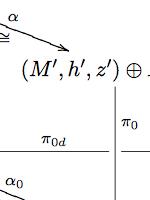 | lee-wilczynski.tex | A piece of math and pictures submitted by Dariusz Wilczynski. He writes:
I'm sending you a one-page excerpt from a paper of mine that was published in the American Journal of Mathematics. Hope you will find it useful. I'm sure Ross Moore and others can provide more interesting examples of the power of Xy-pic. |
 | cover.tex | Plamen Tanovski writes:
my contribution is actually nothing special in the world of TeX. I've used the cd-cover class and the tiling macros from PSTricks to produce nice looking enclosure for my sample cd. The idea for the cover is based upon a title page by Imre Reiner. The interesting point, I think, is the use of ornaments. Ornaments have accompanied the letters through the whole history of the book. Being once *the* typographer's adornment for centuries, ornaments are nowadays -- where books are made by graphic designers -- almost forgotten and replaced with blurred meaningless color spots (quoting the german typographer H.P. Willberg: "visuelles Hintergrundrauschen" [visual background hissing]); maybe because it's not easy to make patterns and borders by clicking around with the mouse. So I think it is a great chance for TeX to bring back ornaments in the books. There are enough tools to do that in TeX/PostScript/MetaPost etc. and fortunately there are still many ornamental fonts available. P.S. I know, there are some articles on tiling with TeX, but they are most technically oriented. Mine is a real life example. |
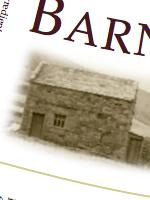 | BarnstormingBitter.tex | A Beer bottle label created with TeX. I could use a bottle right now...
Submitter Kester Clegg writes: The labels are designed to be cut out and put round the neck of beer bottles (my home brews as it happens!). One thing I like about using latex instead of a normal graphics program is that I get minute control, I can work on a single label for speed, and when I'm finished, I uncomment my 'block' of labels and bingo! I get the whole lot at once! |
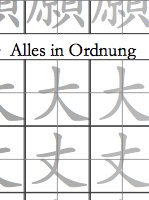 | kanji-sheet.tex | Kanji characters, slowly fading out to help you practice. This has been created with ConTeXt and Metapost. Christopher Creutzig writes: I needed some practice sheets for my Japanese handwriting and cooked up these files. |
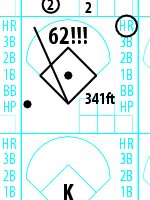 | scorecard.mp scored_game.tex | Christopher Swingley writes:
This is a Metapost program and wrapper TeX document that generates a baseball scorecard, as well as demonstrates the scoring from the game where Mark McGwire broke Roger Maris' season home run record in 1998. The Metapost code includes a variety of locations, paths, and functions to make it easy to generate nice-looking baseball scorecards with or without the scoring. I've included the Metapost source, as well as the wrapper file I use to produce PDF versions for printing on letter sized paper. |
 | diagram.tex | Submitter Bob Tennent writes:
Hi. I thought this might be of interest, primarily because it shows what can be done *without* WYSYWYG tools. The source consists of just 148 lines of LaTeX and uses John Reynolds's fine macros package for diagrams (diagmac). The diagram was designed to be viewed on the web. |
 | No source available | Martin Budaj writes:
This contribution is a little bit unusual. It is a cave map produced by Therion, free cave mapping software. It uses MetaPost for drawing of map symbols such as passage walls or lakes, and pdfTeX for all the typesetting. It demonstrates the incredible flexibility of TeX and MetaPost. I hope it will be interesting, although there is no source code included. (Therion uses its own input language; MetaPost and TeX files are generated at the run-time.) The Therion homepage is on the http://therion.speleo.sk |
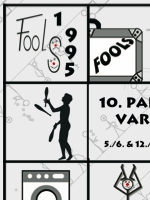 | program_sample.tex | Note: the file is 5.8MB Christopher Creutzig writes: It shows a Metapost-generated background, XeTeX-set text, everything combined with ConTeXt using pdfTeX. I've used Acrobat to extract only a part of the whole file, mostly because the complete thing makes sense only if you cut and fold it the right way |
 | poster.tex | Jonny Butler writes:
It's a poster I made for presenting at a linguistics conference. I was wary about trying to do something like this with LaTeX at my level, but I was astonished at how easy it turned out to be (even though it is in places a bit of a hack...) |
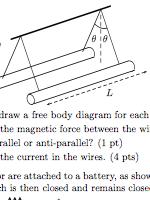 | ps_s_1b.tex | A physics problem sheet with pictures created with pstricks.
Submitted by Christopher Allen. |
| Case (click for document) | Source | What it is |
|---|---|---|
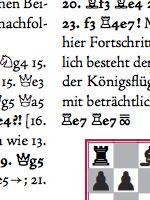 | Blatny-Klinger.tex Blatny-Klinger-readme1st.txt | Note, this impressive example is 1.1MB in size.
Submitter Ulrich Dirr writes: Here are a few pages of 352 from a chess book (Kindermann/Dirr: Französisch Winawer, Band 1: 7. Dg4 0--0). Typesetting was done by PDFLaTeX (then v0.14h). Printed on art paper using a two colour setup (black and a spot color), the book was published in 2001 by Chessgate AG. The interested TeXie will recognize the creation and utilization of special fonts (Adobe Jenson (with special ligatures and kerning for german), ITC Legacy Sans, Castellar (initials), and self-made chess fonts for figurine notation and diagrams ) I've downsampled the images to 96dpi. Otherwise the file would have been 3.2MB. |
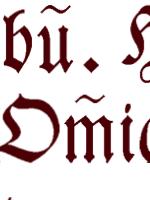 | No source available | I think you need to zoom in or print this document if you really want to see
how nice it is. And remember its advice: you need at least a 66MHz processor
and 32MB memory for TeX!
Submitter Karl Berry writes: Peter Flynn's LaTeX brochure is pretty amazing, IMHO. |
 | 0309Newsletter.tex | Bob Kerstetter writes:
Here are the source files and PDF output for a monthly newsletter. There may be better ways to do this, but it works okay and Alt-N is happy with it. Some of the word spacing in the narrow columns is a too large. I reduced it from terrible to livable by rewriting and doing copy fitting. The newsletter makes extensrive use of minipage and has lot of links. I would not call it interactive, however. It's more of a practical way to communicate with our distributors and resellers. It is not pretty like lots of things on the showcase, but it does show a practical way of using LaTeX for a newsletter. It is certainly easier for me to do this than with a page layout program where all of your content is trapped inside the document. |
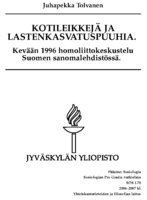 | gradu-20070208-1328-src.zip sosl70c.print.pdf | How to make two different types of output from one source with LaTeX. This is something that for instance ConTeXt has been built for, but it is possible in LaTeX as well. Click the image for the screen version. Click the link in the box to the left of this text for the print version. Enjoy reading it (if you can read Finnish, that is). Juhapekka Tolvanen writes: This Master's Thesis has no math at all. This is my Master's Thesis for sociology. I am Master of Social Science now. Language is Finnish. There is not very clever LaTeX-trickery, but it is really big cavalcade of LaTeX-packages. I was able to create two different layouts from same LaTeX-source. I learned very much LaTeX in that process when I wrote my Master' Thesis. Sources are available under the DSL (Design Science License). Yes, my Master's Thesis is free in the sense of freedom and price! |
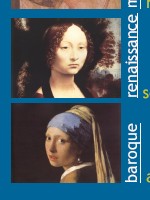 | learning_early.tex | This is a nice screen-oriented document. Note: this document is 2.4MB in size. António Almeida writes: I submit here a document that I wrote using pdfLaTeX with some packages. It has the peculiar characteristic of being written with easy to get fonts, besides the CM family and the 35 standard fonts Adobe. This is a document that introduces Early Music to all audiences. It can be found in http://perusio.com . |
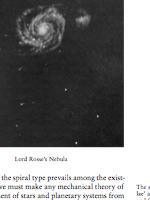 | csky-sample.tex | Another fine typesetting example, which shows marginal notes and graphics. It is created with the ConTeXt package. Submitted by Bill McClain. |
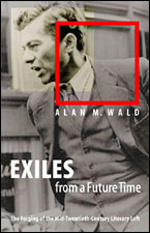 | 6553-specs.pdf | Sometimes the most beautifully typeset non-mathematical books are actually made
with TeX.
Submitter Larry Tseng writes: [This is] an example of what TeX can do, when used by people who make their living setting type to implement the type specifications and layout of a distinguished book designer. The book is Exiles from a Future Time by Alan M. Wald, University of North Carolina Press. The design is by Richard Eckersley, whose achievements in book design have earned him the designation of Royal Designer for Industry by the Royal Society of Arts. His work is also in several museum collections, including the Cooper-Hewitt National Design Museum, Smithsonian Institute. The sample is in the form of double-page spreads, intended to be viewed with Acrobat version 5 and above. Acrobat's full-screen mode with text-smoothing are recommended for best results. Some restrictions have been placed on the pdf content to discourage printing and extraction. Included also are the type specifications in a separate pdf -- perhaps a much more interesting alternative to style files and other sources given that the book was set with Buffalo TeX, an in-house package that has its own special control sequences and syntax. For people who would like to see more of this sort of thing, we've set up a kind of "extension to the official TeX showcase" to show the work of other book designers that we have worked with in the past, all typeset with TeX of course. Simply log on to the showbooks page at http://www.tsengbooks.com/. |
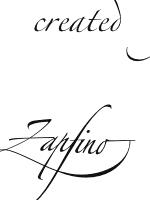 | No source available | Look at this example and especially, zoom in to the text. Submitter
William Adams writes:
It is a small French gatefold card which one can print to fit any decent size paper and then fold in half twice to get a card. It is typeset in Zapfino using Omega and techniques which I hope to document and present presently. I hope everyone will enjoy it in the spirit in which it is offered. |
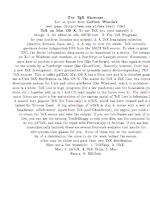 | ShowcaseCircular.tex | This example shows TeX's power to set in strange paragraph shapes. TeX has been told the shape, but for the rest TeX just does its normal job, breaking lines into words and paragraphs into lines. Submitted by Dariusz Wilczynski. |
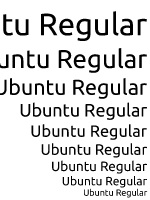 | ubuntu_font_study.tex | Submitter István Szántai writes:
Yesterday I was playing with the Ubuntu Font Family with LaTeX, and I came up with a pretty neat layout. |
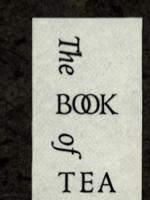 | No source available | Typography from The Book of Tea by Okakura Kazuko, submitted by
William Adams
The complete book (including the graphics shown in the icon) can be downloaded here (2.7MB) |
 | pp.tex | Another fine typesetting example showing how well TeX can produce beautiful books. It is created with the ConTeXt package. Submitted by Bill McClain. |
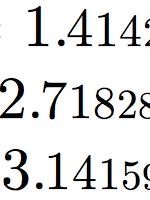 | diminuendo.tex | Submitter Peter Hammond writes:
This is some rather old trickery, using Plain TeX and a readily resizable Postscript font, based on the \length macro example on p. 219 of the TeXbook. The result would be the complete decimal expansion of some prominent rational, irrational and transcendental numbers, in a finite area, except that of course the digits become too small to see (or print) rather fast. (Some of it appears within the cover design for our textbook, Essential Mathematics for Economic Analysis.) |
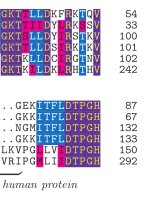 | texshade-eg.tex | Senthil Kumar Murugapiran writes: I work as a Postdoctoral Research Fellow at Ajou University, South Korea. I would like to submit two examples that highlight the use of LaTeX packages: TeXshade and TeXtopo. Inclusion of these submissions in the TeX showcase might be helpful for biologists to venture into learning LaTeX, once they understand what they can do with this wonderful software. I made these figures for an article that was published in The PracTeX Journal. |
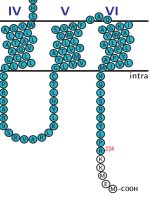 | textopo-eg.tex | Senthil Kumar Murugapiran writes: I work as a Postdoctoral Research Fellow at Ajou University, South Korea. I would like to submit two examples that highlight the use of LaTeX packages: TeXshade and TeXtopo. Inclusion of these submissions in the TeX showcase might be helpful for biologists to venture into learning LaTeX, once they understand what they can do with this wonderful software. I made these figures for an article that was published in The PracTeX Journal. |
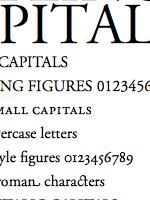 | onetype.tex | A treatise on a typeface by font-specialist William Adams.
It's designed to be printed all on a letter-sized sheet of paper and folded into a small booklet. |
| Case (click for document) | Source | What it is |
|---|---|---|
 | terra.zip | Note: won't display in Mac OS X Preview up to OS X Lion. Acrobat on Mac OS
X displays this properly.
Submitter Orlando Rodriguez writes: The following contribution contains a Beamer presentation, containing a spinning globe. It combines POVray with SWFTools, pdfTeX, Beamer and (hacked)flashmovie. The earth texture is rather large, so it's not included, but a suitable substitute can be found in the web. |
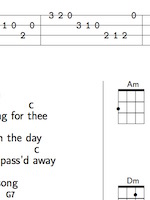 | uke.tar.bz2 | Submitter Mark G. writes: In order to play songs on the ukulele, I devised a set of macros in (plain) TeX and typeset a few songbooks that show lyrics and chords (and sometimes tablatures). |
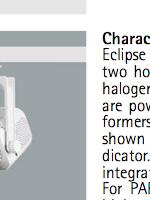 | No source available | An example of a catalog entry automatically created from a vendor's database.
Submitted by Stephan Lehmke. He writes:
I've attached another PDF which doesn't really have a TeX source because it's automatically generated from data, but I find the application itself quite excellent. You can find it among around 800 siblings at www.erco.com (for instance /download/data/_lsp/indoor/system/fr/fr_pollux_119.pdf). |
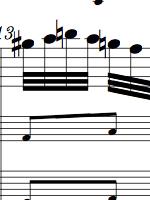 | kv315f.tex | A Music example submitted by Norbert Preining. This is from the Andante KV 315, W.A. Mozart, transcription from D. Taupin |
 | x.README x.makemovie x.mp x.param | Note, this file is 1MB in size.
This example is a funny MPEG movie, created with METAPOST, which is part of the TeX family of programs. It has been submitted by Hartmut Henkel. He writes: I have created a small technical movie (premiere) about a certain species of liquid Indium ion emitter (Liquid Indium Metal Source, LIMS), which sometimes is used in space for propulsion or scientific experiments (e.g. by the company www.vh-s.de where I work). The movie shows the heating of the Indium reservoir until the Indium melts. Forced by a strong electrical field (not shown) the Indium creeps to the tip of a Tungsten needle and builds a so-called Taylor cone there. From the tip of the cone Indium ions are extracted by the same field. --- After some operational time the In reservoir gets empty. Don't take this part too serious :-) It's some 600 frames, drawn by MetaPost one by one, printed, put sheet by sheet on the scanner. Just kidding, it goes through a shell script (under debian Linux) starting with MetaPost, blows up to over 1GByte of .ppm files by ghostscript and then shrinks to the mpeg by mpeg_encode. |
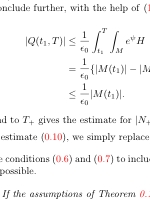 | LM-Volume-manuscript.tex | An example of creating documents with hyperlinks (internal and external) using
the hyperref package.
Claus Gerhardt writes:
I am not sure if this paper qualifies as a TeX showcase example, since nowadays everybody who is writing mathematical papers is using TeX, and these people need not to be convinced, but it might be a showcase for the beauty of hyperref. |
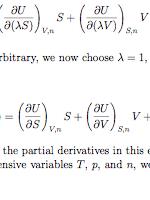 | EulerGibbsDuhem.tex EulerGibbsDuhem.html | This example is just an ordinary article with some math in it. However, using the htlatex tool from the TeX4ht suite, the same TeX source has been used to produce the PDF file you see when you click the icon as well as the web page you see when you click on the EulerGibbsDuhem.html link in the second column. Submitted by Stephen Addison |
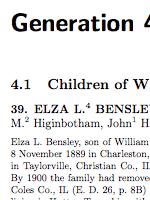 | johnhigexerpt.txt | Submitter Scott Higinbotham writes:
Here is a contribution to your TeX showcase, if it seems appropriate. I do genealogy as a hobby, and I have kept the results of my work in book format almost from the beginning. I used Word for the Mac originally, but maintaining the document through the constant updates resulting from new information was not easy. I wanted something a little more automatic. This was accomplished using a database (4D) to keep the basic information (names, dates, and family groupings), individual text files for the narratives about each individual, and then having the database generate a LaTeX file, which TeX would process and put together in book form, generating a TOC and an index in the usual manner. There is not much fancy TeX code involved, but the result seems to impress even experienced amateurs who have looked at it. It seemed to me that this might be interesing because it is an application which is a bit far afield from the usual disciplines where TeX has taken hold. The example is anexcerpt from the genealogy. |
This showcase does not have very fancy markup. It is created automatically by a perl script and a driver file and I am not an HTML-expert, that is why.
If you want to contribute something that is not already there, or which is better than what is already there, please send me a submission by e-mail. Do not send me URLs or anything that requires work for me to find it or download it, I must set a limit somewhere and I will generally not include items I have to go browsing for. Sorry.
Include the case and make sure it looks good on screen as well as in print (so no bitmap fonts), and if possible some source and a description. If you want, add a JPG or TIFF of 150x200 (width x length) pixels just like the icons above. Preferably, keep your names in sync: foo.pdf for the showcase entry with foo.jpg for the icon. Include source. It does not need to be complete in that it can be compiled and that all necessary support files are there, but it should illustrate how it was done in TeX (or MetaPost or whatever).
E-mail your submissions to tex-showcase at rna.nl.